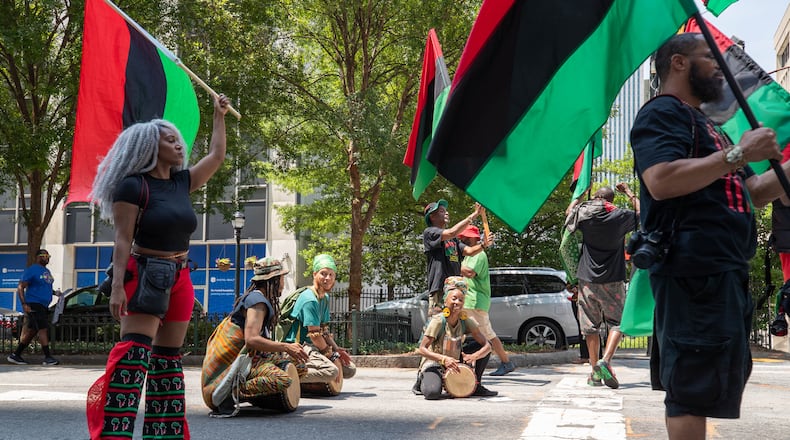Nothing is more certainly written in the book of fate than that Americans will esteem the Civil War’s multitudes of freedom-striving, emancipation-forcing enslavement escapees.
Just not yet.
But a new dimension in Juneteenth’s spirit could speed things.
Brent Leggs, African American heritage director at the National Trust for Historic Preservation, said it was a full half million. That’s one in every eight enslaved Americans.
Credit: Handout
Credit: Handout
Public memory still mostly omits the enterprising Black self-agency that figured centrally in emancipation’s political evolution. But Juneteenth celebrants could foreground the freedom-striving multitudes right now, enriching the Juneteenth spirit and catalyzing year-round esteem — and pleasing nearly all sides in the history wars.
No one whispered “Freedom!” in escapees’ ears. They already knew, and they knew the risks. When they saw opportunity, they acted. How American can you get?
Sean Wilentz, W.E.B. Du Bois, James M. McPherson and other scholars have estimated hundreds of thousands of the slavery-escaping Americans that some historians call self-emancipators, as suggested in the title of the Cambridge University Press book “I Freed Myself: African American Self-Emancipation in the Civil War Era” by David Williams of Valdosta State University.
Columbia’s Eric Foner said that slavery escapees “forced the fate of slavery onto the national political agenda.” Leggs saw in that the “unknown story” of a “catalyst for emancipation” and an example of “uplift” that positions Black Americans “not just as spectators in history” but as actors in it.
Unknown story, yes. Consider even the New York Times bestselling anthology “Four Hundred Souls: A Community History of African America, 1619-2019.” Its 90 Black authors — including co-editor Ibram X. Kendi, anti-racism’s founder — surveyed history comprehensively but didn’t address the self-emancipating multitudes.
Overcoming this puzzling national memory deficit isn’t mainly historians’ job. It’s the public’s.
Historians do have general awareness. Edward L. Ayers, former president of the University of Richmond, wrote that across the South, enslaved Americans “risked everything to escape.”
In “The Long Emancipation: The Demise of Slavery in the United States,” University of Maryland slavery historian Ira Berlin wrote that by “offering their labor and their lives” and acting with “resolute determination,” those multitudes contributed importantly to the Union cause. Many in the North came to see that the Union’s security required slavery’s destruction.
That 2015 book repeated verbatim the most important sentence from Berlin’s 1992 Washington Post op-ed “How the Slaves Freed Themselves”: “No one was more responsible for smashing the shackles of slavery than the slaves.”
Berlin emphasized shackle-smashing by the Union’s 180,000 Black soldiers and 20,000 Black sailors. The movie “Glory” portrayed some of them. More than 135,000, Berlin says, were formerly enslaved.
Some stories of Black resistance to slavery have high visibility, as seen in national esteem for Frederick Douglass, Harriet Tubman and the Underground Railroad. Yet the multitudes of self-emancipators remain mostly unremembered.
That’s why two decades as a history activist on this subject have led me to contrive a deliberately problematic either-or thought question.
It’s May 1861 — mere weeks after Fort Sumter — at Point Comfort, Va., where British North American slavery began in 1619. That’s the Chesapeake Bay’s flat Gibraltar and the site of Fort Monroe, the Union’s mighty, and mighty symbolic, stronghold in Confederate Virginia.
Slavery escapees Frank Baker, Shepard Mallory and James Townsend approach Fort Monroe. They don’t know it, but they’re about to ignite momentous events that will inspire multitudes across the South to risk everything for freedom. The three are never going back to slavery, though no one knows that yet, either.
Pick an answer: As they enter the U.S. Army’s majestic stone citadel to ask for federal sanctuary, are they “slaves” or are they Americans?
Some historians stick to the denotatively accurate word slave despite its connotative freight. That consequential freight gets scanted in public memory.
So the country misremembers, mostly unintentionally, the millions of Americans who helped build it while enduring a quarter millennium — 1619 to the Civil War — of crimes against humanity. They were just “slaves,” right?
Michele Norris observed in “Our Hidden Conversations: What Americans Really Think About Race and Identity” that when Teddy Roosevelt defined Americans, he “did not contemplate African, Latino, Caribbean, Arab, Asian, or Indigenous” ones.
The word American “was clearly understood to mean people of European origin,” she wrote, and this “narrow framing persists today.”
She could look back further, to Abraham Lincoln’s 1858 “electric cord” speech (about energized human connections, not toasters). He too presumed only people of European descent.
But he also told why blood lineage doesn’t matter for being an American. It’s the “electric cord” of the Declaration of Independence, he declared, that will link “patriotic hearts as long as the love of freedom exists.”
I don’t know how many among those self-emancipating American multitudes knew the Declaration, but I know how many knew its meaning and affirmed it with their feet.
It was every last one of them. How American can you get?
Steven T. Corneliussen’s Substack is “The Self-Emancipator,” recalling antebellum abolitionists’ “The Emancipator.”
About the Author
Keep Reading
The Latest
Featured




